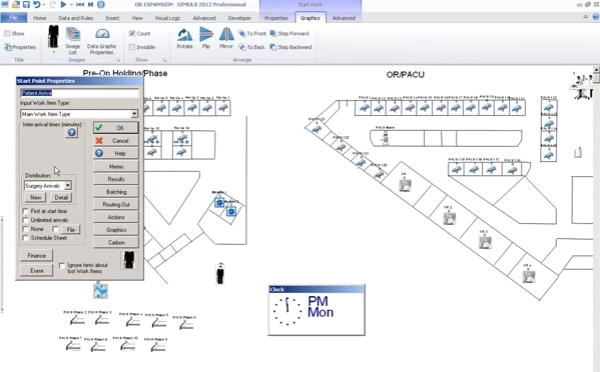Memorial Health System ensures the success of a $31 million OR expansion ahead of construction

- Industry
- Healthcare
- Location
- Illinois, U.S.
- Goals
- Identify the most efficient model for routing patients through an emergency department system
Achievements with Simul8
-
-
Emergency department length of stay decreased by 16%
-
-
Patient satisfaction within emergency department improved from 57th to 99th percentile
-
-
Non-admitted patients length of stay reduced by 27%
-
-
Patients leaving emergency department without treatment reduced by 53%
About the project
Memorial Health System (MHS) is a non-profit healthcare corporation committed to providing comprehensive health services that meet the needs of the community.
Dedicated to providing an outstanding level of patient-centric care since 1897, MHS are continually in search of innovative means of improving patient satisfaction and meeting the healthcare challenges of today.
Simul8 healthcare simulation software provided the insight and results required to deliver substantial process improvements to MHS' emergency department patient flow, visit duration and overall patient satisfaction.
Using simulation for risk-free emergency department performance improvement
Memorial Health System’s level one emergency department is a complex environment with many interacting processes. The 500+ bed tertiary, urban, academic medical centre receives on average 70,000 emergency department visits per year, making it challenging to implement new processes without possibly compromising patient well-being. Within such a fast paced environment, a trial and error approach to testing process improvements is not a viable option.
For this reason, Todd and his team used Simul8's simulation software to analyze MHS's emergency department floor design and throughput to develop and test a new Rapid Clinical Examination Provider model within a risk-free environment.
The goal of the simulation process was to identify the most efficient model for routing patients through the emergency department system and determine the number of provider resources needed for staffing. In addition to this, the simulation highlighted primary macro-factors affecting patient length of stay and constraints that would result in increased patient waiting time or untreated patients.
Utilizing the emergency department floor layout schematic and implementing incremental changes to resource allocation and patient journeys, Todd and his team could confidently present their validated improvement options.
Emergency department performance improvement results
- 27% reduction in the length of stay for non-admitted patients in the emergency department
- 50% reduction in patients leaving without treatment
- 37% reduction in released admit hold time
- Improved patient satisfaction from 57th to 99th percentile


"Simul8 has been a valuable application for expanding our range and depth of analytical abilities. It should be considered an important tool in the design of every robust healthcare performance improvement program."
System Director of Operations Improvement, Memorial Health System


Planning for future demand: simulating a $31 million operating room expansion
In addition to optimizing existing processes, Simul8 was utilized to determine the optimal facilities layout for a $31 million operation room renovation project. With a heavy investment at stake, it was essential that the most efficient layout was selected to maximize return and ensure patient satisfaction. It was also crucial that the new layout and facilities were robust enough to withstand high patient volumes for the foreseeable future.
Referencing existing OR process flows and a proposed architectural design, Todd created an initial simulation in just 60 hours. This simulation allowed for quick identification of potential issues with the proposed schematic. Patient flow between pre-op admission, transport to OR, and post-anaesthesia care units were tested with Simul8's healthcare simulation software to identify potential bottlenecks and inefficiencies.
OR patient flow and capacity planning results
Detecting a bottleneck caused by inefficient elevator capacity, the simulation proved that the addition of a third elevator would achieve a reduction of 30 minutes per patient in overall OR wait times.
With running costs of $54 per minute through operating costs and wait time, this reduction in time per patient gave significant total cost savings for MHS. The cost of adding an extra elevator would be covered by savings within just one week of implementation.
This simulation provided valuable information to faciliate quick, confident decisions by executive leaders. The addition of an extra elevator to architectural plans also ensured that the OR project is capable of accommodating projected patient volumes over the next 20 years.
Learn more about Simul8 for healthcare process improvement
Find out more about how simulation is used by healthcare organizations, read more case studies and access a range of learning resources.
Learn more